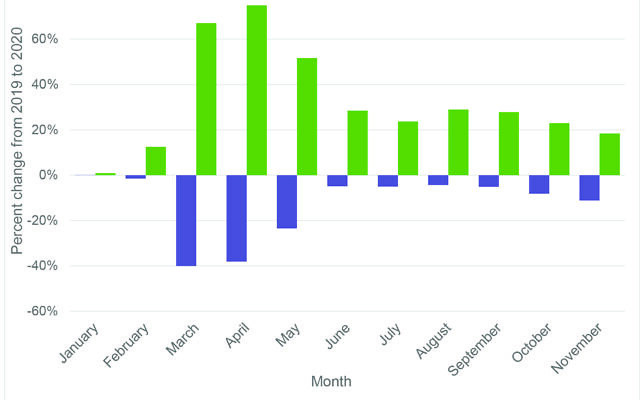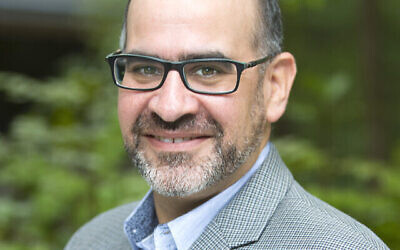Like the grieving period following a death, when the mourner is expected to eventually return to full engagement in life again, today’s youth are struggling to cope after a pandemic that left them socially isolated, seriously dependent on technology, and with tremendous emotional scars from the traumatic change and loss.
For many young people, the pandemic hit at a time in their lives when so much rides on identity and social connection, leading to significant psychological and emotional challenges, as seen in new community programs in Jewish Atlanta focused on mental health.
With May being national Mental Health Awareness Month, the AJT spoke with Jewish Atlanta’s community leaders and those who work with youth about how the psychological and emotional needs of children post-COVID are being met and how to address the ripple effects expected to continue for some time.
The community’s response to the pandemic has evolved with its growing mental health needs, according to Rich Walter, vice president of program and grant making for the Jewish Federation of Greater Atlanta. At the start of the pandemic, the community response focused on funding to meet immediate needs, including food, health and safety, and making sure Jewish organizations were financially stable, with broad strokes in terms of mental health needs, Walter said. More recently, the community’s attention has shifted to mental health as more community members sought help, he said. “A large percentage allocated from the [COVID-19] emergency fund is dedicated to mental health. … As the pandemic lags on more and more, the mental health challenge comes to the forefront.”
Percent change from January-November 2019 to January-November 2020 in mental health claim lines and all medical claim lines. Ages 13 to 18
Source: FAIR Health: “The Impact of COVID-19 on Pediatric Mental Health.”

Percent change from January-November 2019 to January-November 2020 in mental health claim lines and all medical claim lines. Ages 19 to 22
Source: FAIR Health: “The Impact of COVID-19 on Pediatric Mental Health.”
The COVID-19 Emergency Response Fund, announced in April 2020, raised $4.3 million for relief efforts with $3.4 million in grants allocated so far, according to the Federation website.
Earlier this year, the Federation conducted a mental health community survey with Jewish Family & Career Services to assess the needs and what the next action steps should be to address those needs. A total of 515 respondents were polled about stress, coping strategies and what programs they wished existed. The Federation will analyze the results over the next few months “to craft a response and identify the right partners and how to move forward,” Walter said.
Among the findings, the youngest age groups, including those under 25, experienced the most stress across all stress factors. The top stressor of the under-25 set was self-care, 64 percent, followed by isolation, 61 percent, and a high-risk family member, 54 percent.
Top resources requested: activities they can do as a family, virtual exercise classes, and support for virtual learning.
The takeaway from the survey, “Supporting Self Care to Promote Mental Health Resilience” was that even though it looks like the community is reentering life as before the pandemic, many are dealing with trauma and loss, Walter said. “People may have been trying to cope through self-help mechanisms, but as long as this goes on, the challenges become more astute in the community. We try to predict what will happen and direct resources to experts who are able to deal with it.” He said the community has definitely seen an uptick in clinical requests in the last few months.
Meanwhile, some of the newest community initiatives involving mental health include:
Working with camps: JF&CS will connect with Jewish camps to meet mental health needs as they arise over the summer, Walter said.
Synagogue outreach: A $25,000 emergency fund grant JF&CS received last year was renewed to continue to fund synagogue outreach, as some of the needs of the community come through the synagogues, not directly to social service agencies, he said.
Hiring more clinicians: Another $75,000 emergency fund grant will help JF&CS hire more clinicians to meet the backlog of those seeking clinical services, Walter said.
Helping teen parents: JumpSpark teen engagement program offered six sessions with a facilitator called the PhD in Parenting April 14 to May 21, providing parent education for raising tweens and teens in today’s world. It offered parents tools and strategies for identifying mental health challenges and teaching coping skills.
“The relationship between parents and teens is so essential,” said Annie Fortnow, JumpSpark engagement manager. “We feel if we support parents’ mental health, it ultimately supports the family unit.”

Paul Root Wolpe said some kids haven’t been around their peers because of the pandemic
Another program JumpSpark offers for parents of teens is Project Launch, which began May 2 and will run through June 6. It helps parents of high schoolers “launch their seniors to the next step, whether that be college or a gap year,” Fortnow said. The program will help parents build resilience and form small supportive community groups in the fall in partnership with the Federation and area synagogues, she said.
Peer support: JumpSpark also is trying to increase its “community within a community,” Fortnow said. “We need to double down on teen mental health and resiliency and prioritize relationships teens have with each other.”
For instance, JumpSpark is piloting a new Jewish teen boys’ program in which they mentor each other, she said.
For Paul Root Wolpe, director of the Center for Ethics at Emory University, the community priorities should be:
1 – Sensitivity and understanding that youth are still grieving
They may ask: “Why does it have to be my senior year? Why do I have to miss out on parties? These are personal losses they never really get back. People are sad about it. It leads to a greater increase in depression in youth, a spike in suicides.
“We lost a half-million people.,” he said. Some of the students may have lost peers, grandparents, siblings or others. “It’s a time of deep loss. They are grieving not just lost opportunities, but lost people.” And grief counselors may discover the immediacy of those losses may not be fully realized until the students return to their typical routines, he said.
2 – Recognizing that social interactions may be different post-pandemic
“One of the real challenges of the very young, people under 5, is that they had very little social contact” during the pandemic, Wolpe said. “There are 2- to 3-year- olds who never, ever played with other children,” Wolpe explained. “Or even if they are just at the beginning of school, being in the presence of others … sharing, and controlling your anger, you don’t learn on Zoom.”
Educators will need to have “a little more understanding and tolerance, even among kids who should know better” in terms of appropriate behaviors.

Jaime Stepansky believes TikTok should be used to promote mental health.
For older students, being in the presence of a potential romantic partner “is different than interactions on Zoom.” Technology may have enhanced their verbal negotiations, but it may impair their understanding of normal body cues, body language and inappropriate touching, Wolpe said.
Jaime Stepansky, a JF&CS child adolescent therapist, believes Jewish Atlanta’s adults should:
1 – Validate the struggles of teens to develop their own identities
For some, the limited in-person socializing last year may have increased their social anxiety, Stepansky added.
Youth “try to differentiate their identities through social responses. They are constantly navigating the waters” to determine how they are unique and how they fit in, she said. “Having young people at home with their parents so much may have thwarted that a little. … Parents inform them the direction they want them to go but they really need to find their own way. It’s like parents give them a MapQuest and they say, ‘No thanks. I’ll use my iPhone to get there.’”
2 – Understand the impact of technology as an addiction
During the pandemic, Stepansky found that many parents loosened their restrictions on their kids’ technology time. Students “get off Zoom and then they get on their own devices. At school at least they would police and monitor it.”
Stepansky said eight to 16 hours a day of technology use is average for teens she counsels. “It takes them two to four hours of social media or TV on their phone to fall asleep at night.” When she asks about supplements such as melatonin, they say they don’t want to get addicted. “It’s creating a kind of inability to sit with just thoughts and feelings. We were never meant for our attention to be split in so many ways. It’s the antithesis of healthy engagement.”
Youth “need to feel engaged and that they matter” and technology offers that, Stepanksy said. Like alcohol or drugs, it also numbs from boredom, isolation, grief, the change in life, and the lack of control, she said.
Because technology isn’t going away any time soon, Stepansky believes the best method to curb its overuse is through a harm-reduction model and an “if you can’t beat them, join them” response. “What can we do to reach them through technology that would be more beneficial to mental health?”
Her solutions include:
- Using social platforms such as TikTok with entertaining videos to teach teens about mental health. Teens can also make TikTok projects around mental health, she said. JF&CS also has an Instagram, @jfcsclinical, and is presenting “Real Talk” June 10, including teen mental health post-pandemic.
- Encouraging technology use in the home or in social settings be reduced. Set boundaries. Sit and talk, be present and engaged, not dividing attention between interactions and technology. Parents should model this behavior too.

Rich Walter said Federation polled the
community about their mental health wish list
3 – Provide more camp and camp-like activities that are more accessible and affordable.
Stepansky believes camps can bridge the socialization void of the pandemic before students return to the classroom full-time next fall.
“The first couple of days of camp is a detox from technology.” It allows children to engage with others, explore their interests, “be themselves. It strips away the social pressures of school and regular life.”
She said she expects there may be many calls home this summer, but children will be able to work through their anxiety before returning to the physical classroom and in-person socialization.
Not everyone can afford summer camp, so she also encourages other camp-like activities, such as outdoor movies or team building. “If you show a movie, every kid will be on their phone, but if you remove phones or engage young people in playing a game … they’ll talk to each other.”
4 – Consider modifying the school day to allow for more downtime
“Schools realized [during COVID] they could modify the schedule” of school without setbacks. For instance, some schools didn’t have classes on Wednesdays so students could catch up on schoolwork and enjoy a break from virtual classes. Some Jewish schools reduced hours, Stepansky said. Years before schools thought they had to fit more in the day, but COVID taught them otherwise.
The children on sports leagues found that even an hour a week outside to practice during COVID was exhilarating.
“I have bunch of kids who are seniors at Dunwoody [High School]. During senior week, they had to go to school and be outside. They said it was their best week in months. There was free food. They could grab food and see their friends. Sometimes we overthink things. … Give them food and they will come.”
What the Future Holds
In September, the Federation’s Atlanta Jewish Foundation began a series of scenario-planning sessions with 150 Jewish professionals and lay leaders to determine the long-term needs of the community as a result of the pandemic, including in the area of mental health. A report on the findings and funding options aren’t expected for at least two months, said Jori Mendel, the Foundation’s deputy director.
Walter said the Federation intentionally held money back from “the community funds to meet the needs into the next year as we begin to emerge out of this.” Increased staffing to deal with mental health is among the priorities. Engaging in the “new normal” may have to change, he said. For instance, programming may involve neighborhood groups or smaller initiatives.
While traumatic in the short term, the jury is still out on the long-term mental health implications of the pandemic on youth, said Wolpe, the Emory ethicist. “I don’t think in 10 to 15 years, there’ll be a significant difference between 2- to 3-years-olds who went through COVID and ones who did not.” Time will tell, he said. “We are going to see the influence a few years into the future.”
For more information, visit The Blue Dove Foundation https://thebluedovefoundation.org or the CDC’s resource guide, https://www.cdc.gov/coronavirus/2019-ncov/daily-life-coping/parental-resource-kit/index.html
